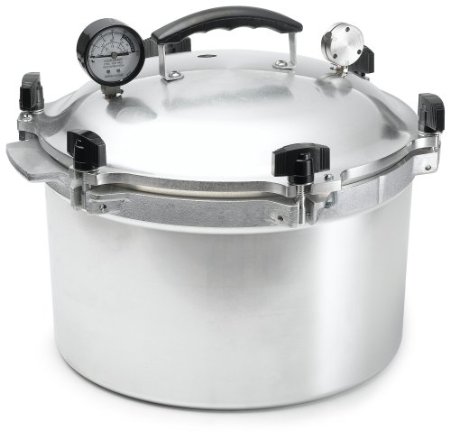Traditional Black Friday brawl at Wal Mart
If people will do this for phones, imagine what they’ll do for food if grocery store shelves aren’t being restocked.
Makes a powerful argument for storing some food to survive natural or man-made disasters. So here’s a Christmas idea – make an investment in your family’s security instead of buying a bunch of cheap made in China junk you don’t need. Here’s a product that’s made in America, will last a lifetime, and could even save your life someday.
I’ve owned one of these for years and preserve vegetables and fruits from the garden with it often. It’s an excellent canner and requires no regular maintenance. There is no rubber gasket to wear out. The reason to use a pressure canner as opposed to hot water bath canning is that it enables you to safely preserve low-acid foods (anything other than tomatoes and acidic fruit like pineapple). Boiling water canning doesn’t achieve a high enough temperature to kill botulinum, requiring the addition of acid like vinegar or lemon juice to low-acid foods, but a pressure canner will preserve pretty much anything you can chop and put in a jar with no added preservatives.
With this canner, you can buy or grow fresh food in bulk, preserve it in glass jars, and it will last 10 years or more without BPA leaching from plastic lined cans. You can even re-use old spaghetti jars and lids in a pinch. I do this all the time (although this is probably not the best idea due to the jars not being as strong as mason jars)
Whenever I bake a chicken, I boil the carcass into stock, then pour the stock into old spaghetti jars. Heat up the canner while the stock is cooking, fill jars with hot stock, place lids, cook 20 min @ 10psi, and voila, jars of chicken stock that will stay good in your basement for 10 years. No preservatives, no leaching chemicals (except whatever comes from the lids, but they’re not in contact with the stock in storage, so that is negligible).
Canning is quite simple but always make sure you follow the directions that come with your canner, and check your seals before eating food. Never eat anything that has a rank cheesy smell (botulinum), even if the seal was good.
This canner will provide years of use and I know mine has long since paid for itself in terms of my ability to store food as long as I want, not to mention the peace of mind from having a buffer of stored food that doesn’t need refrigeration.
You can get proper canning jars here. If you want to try the spaghetti jar method, read on…
*** How to re-use commercial store-bought glass jars with screw lids instead of mason jars for pressure-canning. Do this at your own risk. ***
1. Check the inside of the lids and rims to make sure they’re clean. Boil the lids and jars while heating up the canner to soften up the seals and sterilize them. Make sure the water in the canner comes to within 1″ of the rim of the jars
2. Very important: after packing the jars, do not screw the lids down tightly. Screw them down just finger tight so the lid rsts on the rim, but not tight enough to seal. Make sure the lid is not on crooked. Pressure needs to equalize in the jar during cooking, but the jar should be able to pull the lid down and seal as it cools. This is the key to re-using spaghetti jars. If you screw it down tight, the lid could bend or the jar could break. This would obviously be very, very bad if it happens when you take it out of the canner.
3. After cooking, release the steam valve, wait til the pressure goes down to zero, and take the jars out of the canner. Use some hot pot mits to screw the lids down tight right away.
This is not highly recommended, and mason jars meant for home canning are not that expensive, but I had so many jars laying around I decided to experiment with it and have managed to get good results with recycled jars, so I’m ok with it now. It’s good to know how in case you can’t get mason jars for some reason.
Leave a Reply
You must be logged in to post a comment.





 NoScript extension
NoScript extension
